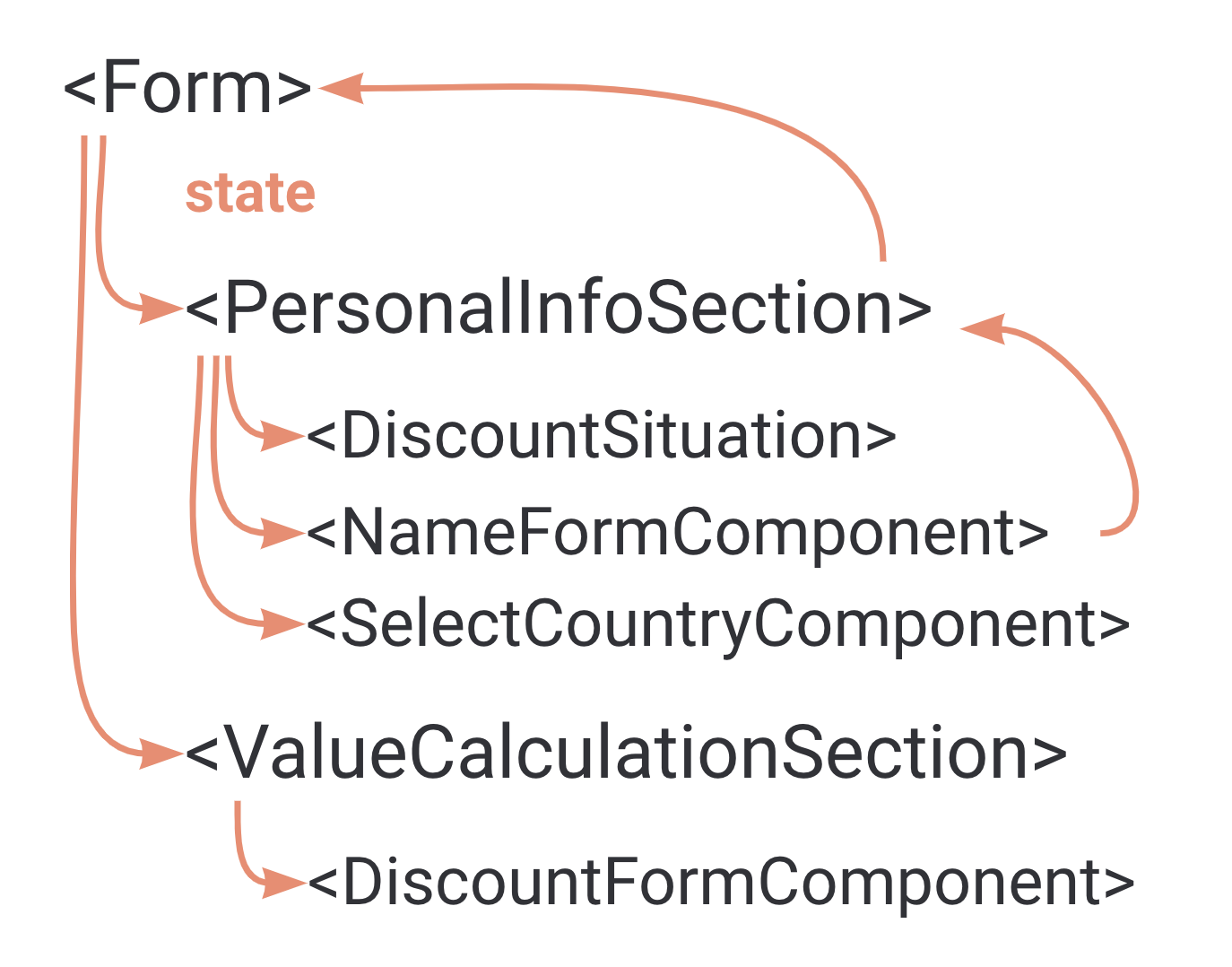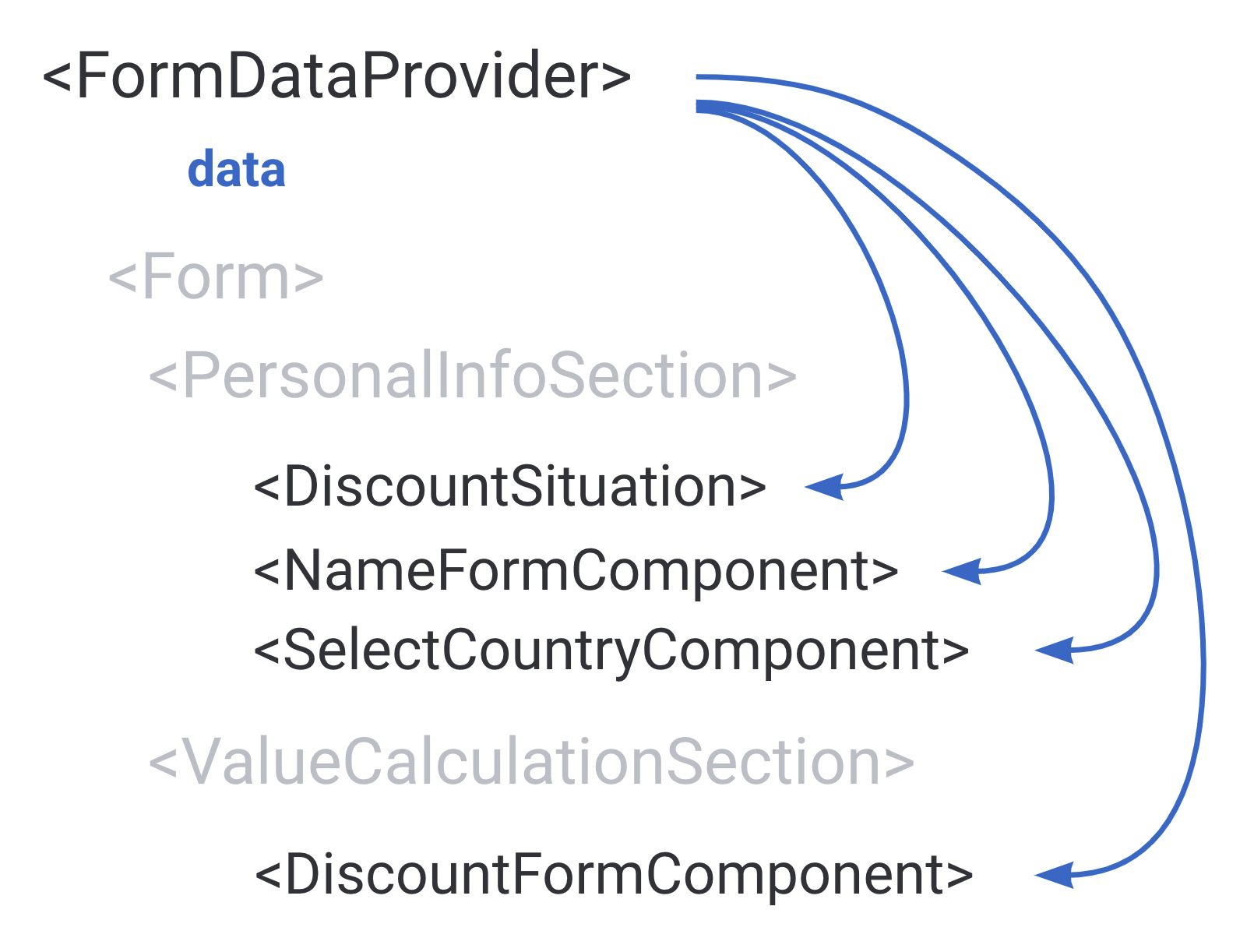How to write performant React apps with Context
자식 컴포넌트로 부모 컴포넌트의 상태를 조작할 수 있는 함수를 props로 전달하면 전혀 상관없는 자식 컴포넌트들의 리렌더링을 일으킬 수 있습니다.

위와 같은 form에 context를 적용하면 상위 컴포넌트에서 form 상태를 관리하면서 props없이 필요한 상태값과 api 함수들을 전달할 수 있습니다.
tsx
type State = {
name: string;
country: Country;
discount: number;
};
type Context = {
state: State;
onNameChange: (name: string) => void;
onCountryChange: (name: Country) => void;
onDiscountChange: (price: number) => void;
onSave: () => void;
};
const FormContext = createContext<Context>({} as Context);
tsx
export const FormDataProvider = ({ children }: { children: ReactNode }) => {
const [state, setState] = useState<State>({} as State);
const value = useMemo(() => {
const onSave = () => {
// send the request to the backend here
};
const onDiscountChange = (discount: number) => {
setState({ ...state, discount });
};
const onNameChange = (name: string) => {
setState({ ...state, name });
};
const onCountryChange = (country: Country) => {
setState({ ...state, country });
};
return {
state,
onSave,
onDiscountChange,
onNameChange,
onCountryChange,
};
}, [state]);
return <FormContext.Provider value={value}>{children}</FormContext.Provider>;
};

하지만 위와 같이 구현하면 onDiscountChange, onNameChange, onCountryChange 함수만 사용하는 context consumer의 경우, state를 사용하는 context consumer에 의해서 context value가 변했을 때 덩달아 리렌더링이 일어날 수 있습니다.
그래서 입력필드별 상태값을 전달하는 context와 api 함수를 전달하는 context를 따로 분리할 필요가 있습니다. 여기서 api의 정의는 state에 의존적이므로 state를 기준으로 memoization으로 처리합니다.
tsx
type State = {
name: string;
country: Country;
discount: number;
};
type API = {
onNameChange: (name: string) => void;
onCountryChange: (name: Country) => void;
onDiscountChange: (price: number) => void;
onSave: () => void;
};
const FormDataContext = createContext<State>({} as State);
const FormAPIContext = createContext<API>({} as API);
jsx
const FormProvider = () => {
// state logic
const api = useMemo(() => {
const onDiscountChange = (discount: number) => {
// this is why we still need state here - in order to update it
setState({ ...state, discount });
};
// all other callbacks
return { onSave, onDiscountChange, onNameChange, onCountryChange };
// still have state as a dependency
}, [state]);
return (
<FormAPIContext.Provider value={api}>
<FormDataContext.Provider value={state}>
{children}
</FormDataContext.Provider>
</FormAPIContext.Provider>
);
};
위와 같은 context는 reducer를 사용해서도 구현할 수 있습니다.
tsx
type Actions =
| { type: "updateName"; name: string }
| { type: "updateCountry"; country: Country }
| { type: "updateDiscount"; discount: number };
const reducer = (state: State, action: Actions): State => {
switch (action.type) {
case "updateName":
return { ...state, name: action.name };
case "updateDiscount":
return { ...state, discount: action.discount };
case "updateCountry":
return { ...state, country: action.country };
}
};
tsx
export const FormProvider = ({ children }: { children: ReactNode }) => {
const [state, dispatch] = useReducer(reducer, {} as State);
const api = useMemo(() => {
const onSave = () => {
// send the request to the backend here
};
const onDiscountChange = (discount: number) => {
dispatch({ type: "updateDiscount", discount });
};
const onNameChange = (name: string) => {
dispatch({ type: "updateName", name });
};
const onCountryChange = (country: Country) => {
dispatch({ type: "updateCountry", country });
};
return { onSave, onDiscountChange, onNameChange, onCountryChange };
// no more dependency on state! The api value will stay the same
}, []);
return (
<FormAPIContext.Provider value={api}>
<FormDataContext.Provider value={state}>
{children}
</FormDataContext.Provider>
</FormAPIContext.Provider>
);
};
위에서 state를 입력필드별로 더 세부적으로 나누면 다른 입력필드의 리렌더링을 막을 수 있습니다.